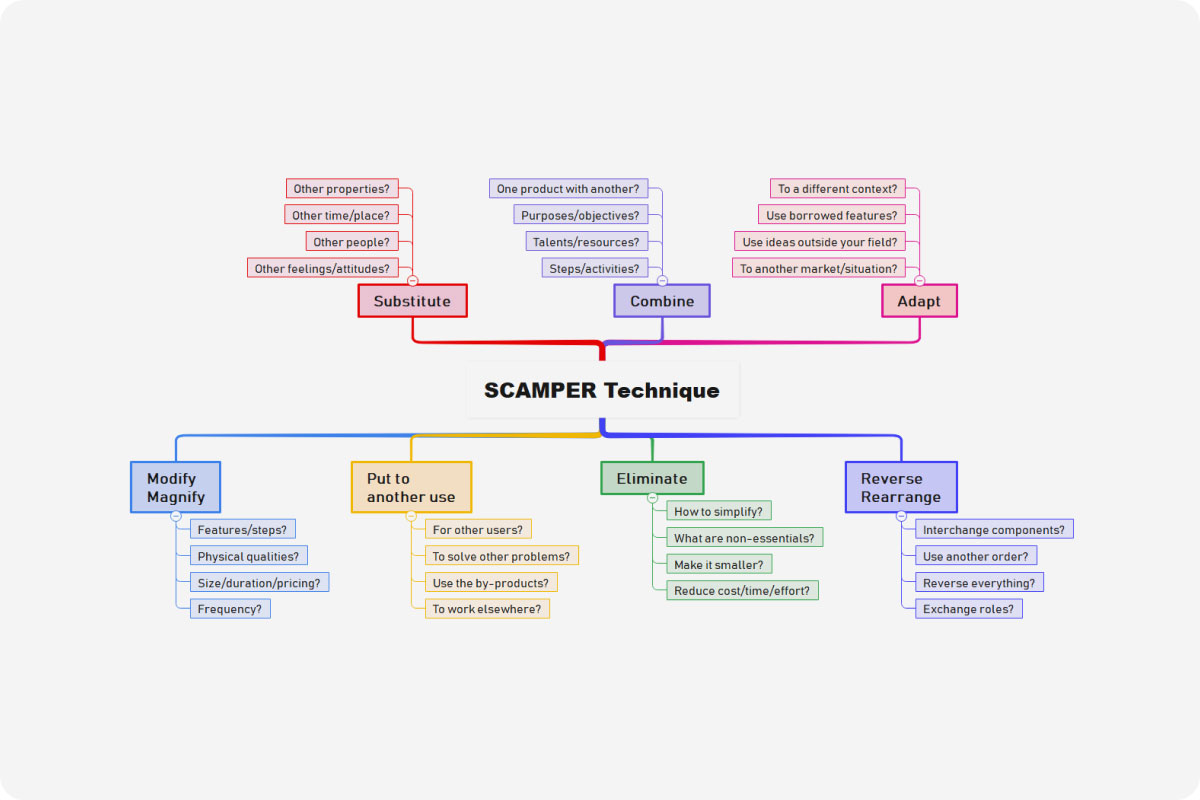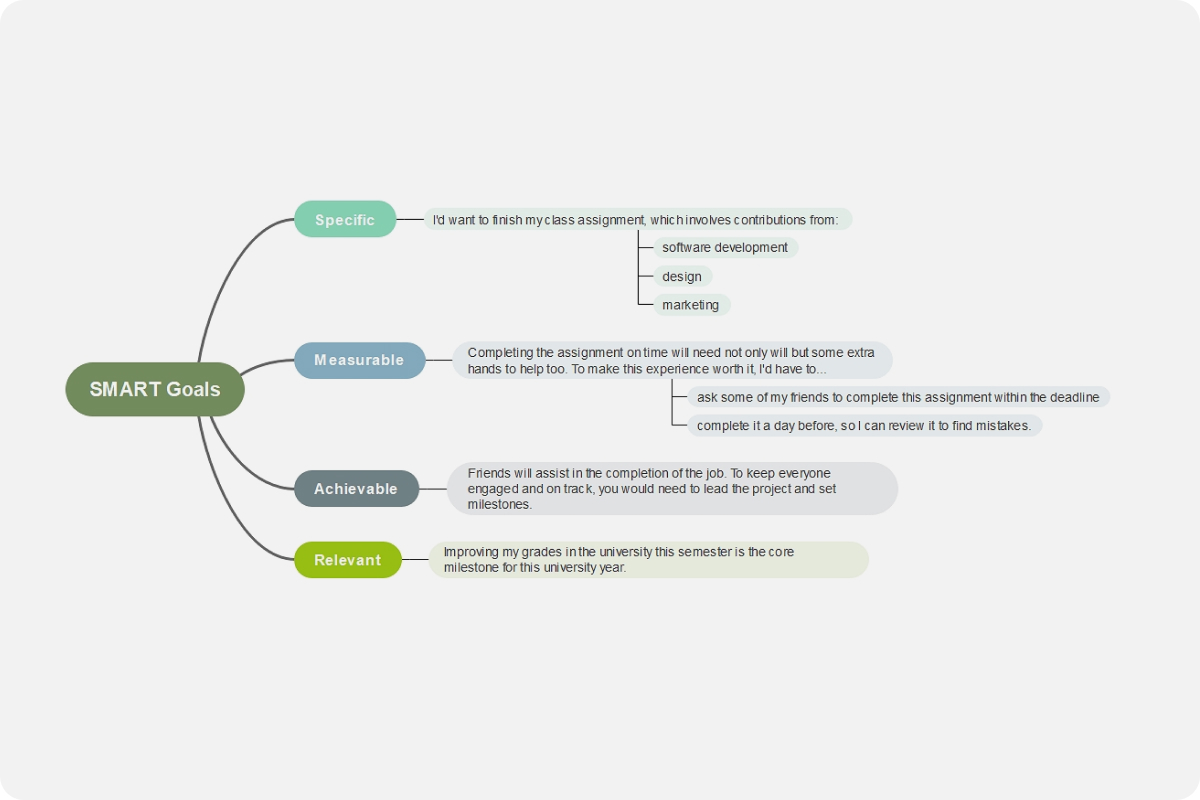SCAMPER Template
Take your problem-solving strategy and ideation to a whole new level.

About the SCAMPER Template
The SCAMPER technique is a good ideation method for brainstorming. It was developed in 1972 by author Bob Eberle, who focused on writing books about creativity for an audience base of young people. The SCAMPER method leads to 7 questions of different focuses, which can aid you in your approach to a problem. Essentially, it gives you 7 unique ways of filtering your problem. This approach leads to unlocking fresh ideas and improved innovations in understanding and solving the problems at hand.
What does SCAMPER stand for?
SCAMPER is an acronym that is broken down into the following keywords.
- Substitute
- Combine
- Adapt
- Modify (or Magnify and Minify)
- Put to another use
- Eliminate
- Reverse
By using these keywords, you can find 7 deep and critical thinking questions beneficial to boosting brainstorming sessions. The questions are there to help guide you to finding innovative solutions for your problems and challenges. These keywords also help you break through blocks or walls in your work approach and thinking process.
When to use the SCAMPER technique?
It's easy to start a SCAMPER-based brainstorming session, regardless of if you're in the same room as your collaborators. Many websites offer templates and pre-populated examples for you to pull from in your creative processes. It is better to be non-linear in your SCAMPER brainstorming sessions; you don't have to begin at a specific key point or feel like you can't come back to touch on it later if you've moved on to a different one. You can bounce between sections if you are the moderator of the sessions.
Here's a guide on how to go about SCAMPER-based brainstorming
1. Get everyone on the same page with regard to the problem at hand. Communicate clearly, set goals, and list boundaries or limits before you begin scampering.
2. Work through each letter and keyword in the SCAMPER acronym. You can use the following breakdown, with included questions, to get the creative juices stirring.
- Substitute: What can be substituted or changed? Is that your product, a problem, or the process? Can you substitute in something else entirely?
- Combine: At this point, considering ways of combining segments within your process or your product may result in achieving something fresh or different. An example could be that some product features may be in conflict with each other or in the way of each other. Can these be combined to bring a better customer experience?
- Adapt: In this portion of brainstorming, consider the parts of your process or product that could be added, adjusted or tweaked, or updated, or modified to improve it. Some standard questions could be: What adjustments can we make to the existing product? Could this process become more flexible in outworking it?
- Modify: Could the process, problem, or product be modified in order to improve results? Can the entire process be modified to be more efficient?
- Put to another use: Is there an alternative use for the product or process? Are there any benefits in using the process or product in a different area?
- Eliminate: Which things can be simplified or removed within the process or product? Can you achieve the results you desire without the parts considered for removal, and if so, how? The main focus in the segment is to remove aspects that don't contribute anything to the table.
- Reverse: Are there any elements that could be interchanged or rearranged in order to drive improved results? Should we consider turning the whole process or product upside down (metaphorically)? Yes? Maybe?
Getting started with SCAMPER Template
If you want to generate ideas using the SCAMPER technique, understanding how it works is imperative, and having software, templates, or tools to use helps the process reach its full potential. There are many tools and templates available to help you create your own SCAMPER template.
These tools help you work through each keyword section, where you're able to add ideas onto sticky notes or similar structures for the subheadings. Once you've worked through the keywords, it's important to review the ideas, vote to find favorites, and shortlist any preferred or worthwhile options.
SCAMPER Examples
McDonald's has now become a household name when it comes to fast food. Although it might not be clearly visible in the 21st century, the company's formula pioneered a new way of doing things completely counter to the old restaurant experience.
The founder, Ray Kroc, already did a lot of work within the company, which makes it easier to identify ideas he implemented that came from using the SCAMPER method.
- Put to other uses: Sell restaurants and property/real estate beyond simply selling hamburgers.
- Eliminate: Self-service options for customers mean that waiters are not necessary, and that means less spending on paying salaries.
- Rearrange: Customers pay for their food before they receive it.
Using the SCAMPER method facilitates lateral thinking techniques, and the fruit of this thinking brings the challenge to the status quo to guide the exploration of new possibilities for your process or product. Your product, for example, could now be experienced and received in a new light, which brings excitement and drives, hopefully keeping your loyal customers happy whilst at the same time reaching a new group and generation of people.


